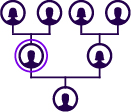 Objective and Method
Objective and Method

 Consensus based on literature supporting clinical presentation and recommendations
Consensus based on literature supporting clinical presentation and recommendations
Literature Analysis on LOPD Symptoms (Neurology): Hierarchy of Evidence

GPs/Peds/IM-Specific
Clinical Presentation for Pediatric/Juvenile* and Adult# LOPD Proposed During the First Meeting
 ► Difficulty in climbing stairs
► Difficulty in climbing stairs
 ► Difficulty in standing up from a chair
► Difficulty in standing up from a chair
 ► Difficulty in washing the hair
► Difficulty in washing the hair
 ► Difficulty in placing an object at a level over the head
► Difficulty in placing an object at a level over the head
 ► Muscle cramps and exercise intolerance
► Muscle cramps and exercise intolerance
 ► Difficulty in breathing at rest or on effort
► Difficulty in breathing at rest or on effort
 ► Feeding/swallowing difficulties and jaw muscle fatigue
► Feeding/swallowing difficulties and jaw muscle fatigue


High CK/elevated LDH, ALT,and AST


Family history of unexplained muscle weakness or respiratory failure
GPs/Peds/IM-Specific Diagnostic Algorithm Proposed During the Second Meeting

 Conclusion
Conclusion

RECOMMENDATION
Testing for Pompe disease must be done if any one specialty-specific symptom plus elevated CK/LDH/ALT/AST or a family history of unexplained muscle weakness is present.
*The age of patients with pediatric/juvenile LOPD ranges from 1 to 17 years; #The age of patients with adult LOPD is usually 18 years and above.
ALT: Alanine aminotransferase; AST: Aspartate aminotransferase; CK: Creatine kinase; DBS: Dried blood spot testing; DMD: Duchenne muscular dystrophy; KSA: Kingdom of Saudi Arabia; LDH: Lactate dehydrogenase; LGMW: Limb–girdle muscle weakness; LOPD: Late-onset Pompe disease; MG: Myasthenia gravis; SMA: Spinal muscular atrophy; UAE: United Arab Emirates.
Al Shehri A, Al-Asmi A, Al Salti AM, et al. A multidisciplinary perspective addressing the diagnostic challenges of late-onset Pompe disease in the Arabian Peninsula region developed from an Expert Group Meeting. J Neuromuscul Dis. 2022;9(5):661–673.
MAT-KW-2300242 V1 Jul 2023